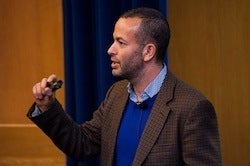October 22, 2012 — In today’s world, where deadly viruses like bird flu or SARS can spread from continent to continent in a matter of hours and there’s real danger of a pandemic, we should all be “a little worried all the time,” says Nathan Wolfe.
But Wolfe, AM ’97, SD ’99, also knows that scientists today have powerful new techniques to help track and contain killer bugs—and that the number of good microbes far outweigh the bad ones.
Wolfe talked about the latest virus-fighting methods and his own experience as one of the world’s top “virus hunters” at Harvard School of Public Health (HSPH) October 11, 2012. Founder and CEO of Metabiota, author of the book The Viral Storm: The Dawn of a New Pandemic Age, and a visiting professor in human biology at Stanford University, Wolfe was keynote speaker at HSPH’s annual meeting of The Leadership Council, a group of more than 180 of the School’s top volunteers and donors.
The power of viruses
To emphasize how quickly viruses can spread, Wolfe presented two slides depicting worldwide air travel routes. One showed them in 1933, illustrated by just a handful of red lines linking several major cities. The second slide showed current routes, with hundreds of overlapping red lines. “What happens in Vegas really doesn’t stay in Vegas,” said Wolfe.
Wolfe worries about how easy it is for new viruses to emerge. For instance, if a person is infected with two different viruses, those viruses can reproduce to form a new ‘daughter’ virus that combines genetic information from each of the original ones.
Another concern is that people can be infected with viruses for a long time but not know it because they have no symptoms. This was the case with AIDS, said Wolfe, which scientists now know had its origin before the Great Depression. Originally a chimpanzee virus, it jumped to humans, but didn’t register on the world’s radar screen until the early 1980s when it began affecting large numbers of gay men in the United States.
Sequencing virus genes
Through Metabiota and its sister nonprofit, Global Viral, Wolfe and colleagues track and study new viruses, working in viral hotspots all over the world. They examine samples in makeshift labs in remote locations and try to determine each virus’ origin. Many viruses come from animals—good news, Wolfe said, because it means “there is a process by which viruses emerge, and we can monitor the interface between human and animal populations.”
In late September 2012, Wolfe and colleagues reported in PLoS Pathogens about discovering a never-before-seen variant of the rabies virus in Bas-Congo, in the Democratic Republic of Congo. After three people developed hemorrhagic fever symptoms—two teens who later died and a nurse who cared for them—Wolfe and colleagues collected a few drops of blood for evaluation. All tests for a range of hemorrhagic fever diseases came back negative.
“Usually, once something tests negative, that’s the end of the road,” Wolfe said. “But now … we can use metagenomics and direct sequencing to take a little drop of blood and sequence all of the genetic information. We can get an entire blueprint.”
After finding one gene that resembled a rhabdovirus—the category that includes rabies—Wolfe and colleagues pieced together the virus’ entire genome. That’s how they knew that they’d found a rhabdovirus with hemorrhagic symptoms—something never seen before.
Once scientists have a blueprint of a virus’ genome, they can literally “bring it back to life” in the lab through a new technique called reverse genetics. It’s an important tool for studying how viruses work but must be used with caution. In the hands of terrorists, Wolfe acknowledged, this technique could post a grave threat. “Whatever we’re doing that’s cutting-edge in the lab now is going to be do-it-yourself biology within the next ten years,” he said.
“Big data” can also help fight the spread of viruses. Wolfe said scientists can combine the “digital exhaust” from the millions of cell phone calls people make with disease prevalence data to get a clearer picture of how disease is spreading—which can help them figure out how best to stop it.
photo: Aubrey LaMedica
